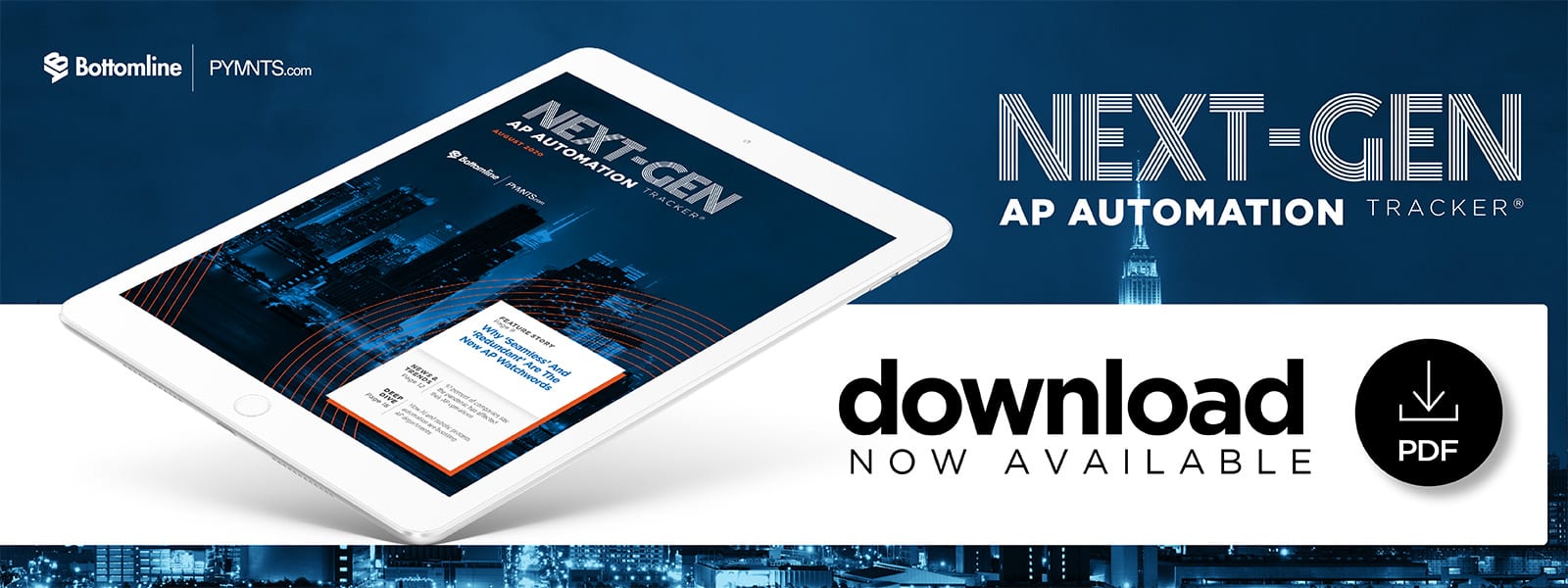Businesses are seriously examining how to retool their accounts payable (AP) strategies as they work to better endure a shifting economic landscape. Thirty-eight percent of companies have already reported adopting AP automations this year — a leap from the 24% who did so in 2019 — and organizations may be finding that moving to cloud-based, remote work-friendly setups is an upgrade that cannot wait.
Enabling staff to safely work from home during the COVID-19 pandemic is not the only factor spu rring AP upgrades, however. Corporate buyers are trying to balance their businesses’ desires to hold onto funds during a time of financial instability while simultaneously meeting vendors’ needs to be paid promptly due to those suppliers’ own increased financial strains. These two stressors are prompting some business-to-business (B2B) payers to use virtual cards to give quick settlement times to vendors while buyers themselves do not have to move money from their bank accounts until the card bills are due
rring AP upgrades, however. Corporate buyers are trying to balance their businesses’ desires to hold onto funds during a time of financial instability while simultaneously meeting vendors’ needs to be paid promptly due to those suppliers’ own increased financial strains. These two stressors are prompting some business-to-business (B2B) payers to use virtual cards to give quick settlement times to vendors while buyers themselves do not have to move money from their bank accounts until the card bills are due
The August “CFO’s Guide To Digitizing B2B Payments” examines how companies are updating their AP approaches to protect their cash flows, support their vendors and enable their financial departments to operate remotely.
Around the B2B Payments World
Virtual cards may be positioned to gain greater traction among B2B payment flows during the pandemic, with vendors that once objected to the card processing fees now eager to accept the payment instrument because it delivers funds faster than paper checks, according to a recent report. This method is also becoming more compelling to buyers that have switched to conducting most of their spending online and no longer see a downside to virtual cards’ inability to be used in-person.
Companies are also turning to digital tools to accelerate o ther parts of the AP department. A new study of 500 businesses found that 78% had upgraded their AP in an effort to trim down invoice processing times. This benefit was an especially strong motivator behind smaller companies’ modernization efforts, even more than for larger businesses.
ther parts of the AP department. A new study of 500 businesses found that 78% had upgraded their AP in an effort to trim down invoice processing times. This benefit was an especially strong motivator behind smaller companies’ modernization efforts, even more than for larger businesses.
Businesses may not be regarding their AP upgrades as simply quick fixes to tide them over until the pandemic ends and operations are able to return to normal. They may instead expect to maintain their new processes in the long-term and keep adopting new tools going forward. A recent executive survey found that 84% of respondents expected new technologies to improve company productivity now and after the pandemic ends.
Find more about these and all the rest of the B2B payments headlines in the Report.
Pulling Back the Curtain On the Entertainment Industry’s AP Fixes
Demand for digital entertainment is soaring during the pandemic, and media companies that want to be able to serve that demand must keep their content creators loyal. That requires paying everyone from one-time photograph contributors to actors with recurring parts on TV shows in ways that are timely and convenient for these professionals — which is often easier said than done. Media companies with  old-school, manual approaches can struggle with lengthy payment timelines, according to Ed Klaris, CEO of intellectual property and royalties-focused consulting and managed services firm KlarisIP. TV companies in turn are especially likely to use complicated formulas for determining payouts, an approach that can leave actors guessing about how much they will earn and lead to soured feelings if their estimates do not match the final payments. In this month’s Feature Story, Klaris explains how straightforward contracts and digital AP dashboards can reduce these frictions and bring much-needed streamlining to payments in the digital entertainment sector.
old-school, manual approaches can struggle with lengthy payment timelines, according to Ed Klaris, CEO of intellectual property and royalties-focused consulting and managed services firm KlarisIP. TV companies in turn are especially likely to use complicated formulas for determining payouts, an approach that can leave actors guessing about how much they will earn and lead to soured feelings if their estimates do not match the final payments. In this month’s Feature Story, Klaris explains how straightforward contracts and digital AP dashboards can reduce these frictions and bring much-needed streamlining to payments in the digital entertainment sector.
Download the Report to get the full story.
Deep Dive: How the Pandemic Inspires AP Upgrades
Corporate buyers are taking fresh looks at their AP approaches during the pandemic and want greater visibility into their cash positions and upcoming payment obligations. Precise, up-to-the-moment data can prepare buyers to decide whether they would benefit most from paying vendors early and earning discounts or by waiting until their invoices become due so that they can retain more cash on hand in the meantime, for example. This month’s Deep Dive examines how the pandemic has impacted AP priorities as well as the technologies and strategies companies are implementing to tackle their new needs.
Get the scoop in the Report.
About the Report
The August 2020 “CFO’s Guide To Digitizing B2B Payments,” a PYMNTS and Comdata collaboration, examines how companies are updating their AP approaches to protect their cash flows, support their vendors and enable their financial departments to operate remotely.

